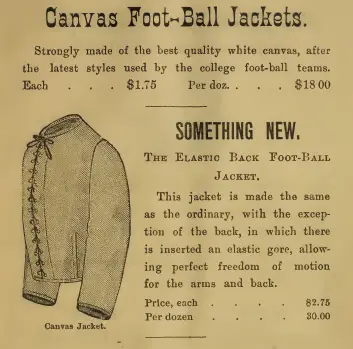With the University of Oregon spring football practice starting Tuesday, this is as good a time as any to refresh everyone’s minds about how far things have come — really, really, really come.
And, oh, how some things haven’t changed at all.
No, we are not talking new fast legs at receiver for the Ducks (Tacoi Sumler, B.J. Kelley, Devon Blackmon, et al) or the reassuring and revolving talent at quarterback (Bryan Bennett and Marcus Mariota).

A page from the 1888 “Foot-Ball Rules and Referee’s Book”
Rather, we’re talking old stuff, as in the 1888 “Foot-Ball Rules and Referee’s Book,” which I stumbled across this week in an online archives maintained by the Library of Congress. The book was published for the American Intercollegiate Foot-Ball Association, a rather select group if there ever was one, be that its five members were named Harvard, Yale, Princeton, Wesleyan and Pennsylvania (Oregon played its first game in 1894). And while not exactly scintillating reading, the version I downloaded nonetheless provides a way-back look at the sport and, well, some chuckles.
Here are a few of the rules in place (spelling as is) the same fall that Benjamin Harrison defeated Grover Cleveland for the U.S. presidency:
Rule 11 — The ball is dead when the holder has cried down, or when the referee has cried down, or when the umpire has called foul.
Rule 14 — No man shall act as an umpire who is an alumnus of either of the competing colleges.
Rule 17 — No one wearing projecting nails or iron plates on his shoes shall be allowed to play in a match. No sticky or greasy substance shall be used on the person of players.
Rule 27 — A player shall be disqualified for unnecessary roughness, hacking, throttling, butting, tripping up, intentional tackling below the knees, and striking with closed fist.
Rule 36 — The following shall be the value of each point in the scoring: Goal obtained by touch-down … 6; Goal from field kick … 5; Touch-down failing kick … 4; Safety by opponents … 2.
The book also features the association’s “Constitution” — all 11 articles. Among the nuggets are these:

A forerunner of the “red-shirt”?
Article II, Section 3 — The annual assessment shall be $25 from each college, and out of the total sum $75 shall be expended for a Championship Pennant.
Article IV, Section 2 — The two leading colleges of the preceding year shall play in or near New York.
Article V — In all the championship games the net receipts shall be equally divided between the contesting colleges.

Lace ‘er up!
A flurry of advertisements follows the book’s sections on the association’s rules and constitution. There is one for “New Patent Foot-Ball Inflator” (being sold for $1). Another for “Foot-Ball Shoes” — light canvas for $2.25 and a “Best French calf, high-laced, extra strong” pair for $6.50. And a third ad, complete with a drawing, for “Canvas Foot-Ball Jackets” — which must have sufficed as a jersey — that went for $1.75 each.
My favorite ad, though, promotes another book, this one by legendary coach Walter Camp (he was coaching Yale in 1888 and was responsible for many of the sport’s rules) entitled “How to Coach a Team.” The price, by mail, was 25 cents. And the ad includes this description: “This Book is intended as a Guide to Assist Captains in Coaching their Teams, so as to Get as much Foot-Ball as possible out of the Material at their command.”
Think Chip Kelly doesn’t ponder the same thing?
So when the 2012 Ducks go over some new rules this spring — kickoffs are moving from the 30 to the 35-yard line and touchbacks from the 20 to the 25-yard line — keep in mind what all the players from the past 124 years have had to endure.
And the next time someone calls out Oregon for its 500-plus uniform combinations, remind them that style has long had a place on the gridiron — and in the form of various garments.
“English-ribbed Foot-Ball stockings,” anyone?
Related Articles:
These are articles where the writer left and for some reason did not want his/her name on it any longer or went sideways of our rules–so we assigned it to “staff.” We are grateful to all the writers who contributed to the site through these articles.
